5 Things You Need to Know About Cupid
Cupid is the ancient Roman god of love and the counterpart to the Greek god Eros. It’s him who inspires us to fall in love, write love songs...
Valeria Kumekina 14 June 2024
When one thinks of any Golden Age, the first thing that comes to mind is the 17th-century Netherlands at its glory – the Dutch Golden Age. The most celebrated period in the history of the Netherlands, associated with great artists such as Rembrandt van Rijn, Johannes Vermeer, and Frans Hals. Some perceive it as an era of luxurious beauty and sophisticated culture, proudly exhibited in museums. Meanwhile, others see it as a symptom of an early capitalist society, fueled by colonial expansion. And you? Do you know what exactly the Dutch Golden Age meant and to whom?
The Dutch Golden Age, or de Gouden Eeuw in Dutch, denotes the 17th-century Netherlands, emphasizing its economy and culture. The term was first used in the Dutch language in the mid-16th century, due to early Dutch translations of the Ovidian Metamorphoses. The concept of a Golden Age is in fact an ancient one. The Latin term, aurea aetas is a classical myth found in the writings of Hesiod, Ovid, and Virgil.1 An art historian, Maria Holtrop writes: “For all three of them the aurea aetas is a paradise that is either lost or something we should strive for.”2 In European history the Golden Age concept became the topos in literature and political propaganda. For instance, the Medici family applied the myth in order to legitimize their power in Florence.3
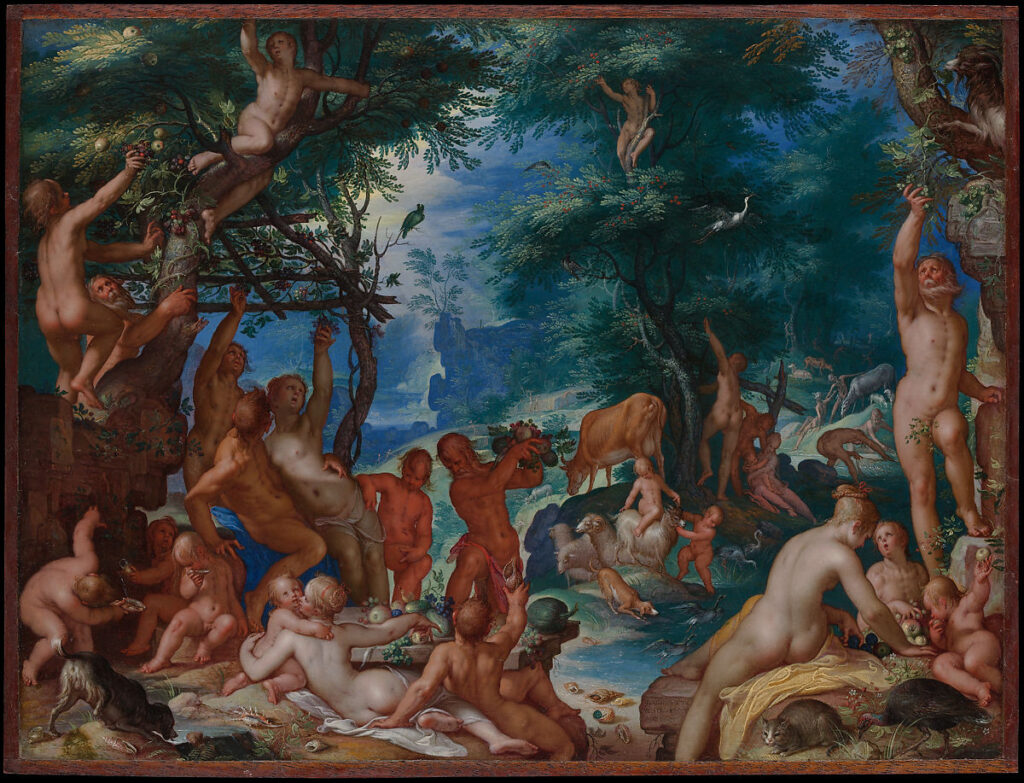
Joachim Wtewael, The Golden Age, 1605, The Metropolitan Museum of Art, New York City, NY, USA.
The painting entitled The Golden Age (1605) by Utrecht artist Joachim Wtewael, referred to the classical myth taking its subject from the opening pages of Ovid’s Metamorphoses. It describes a land where “spring was everlasting,” “streams of sweet nectar flowed” and mankind lived peacefully and contentedly. Nowadays, the Dutch people would point to the Night Watch or the Anatomy Lesson of Dr. Tulp by Rembrandt van Rijn when asked, which artworks symbolize the Golden Age best. In the 17th century, however, when asked the same question, literate Dutchmen would point the Wtewael’s painting.
The first usage of the term gulde Eeuwe coincided with the time when the Netherlands was struck by a civil war. The Netherlands, then known as the Seventeen Provinces, was involved in a military conflict with their sovereign, the Spanish Habsburgs. The Dutch War of Independence, widely known as the Eighty Years’ War, ended in 1648 with the Peace Treaty of Münster, which resulted in the creation of an independent Dutch Republic and brought longed peace to the region.
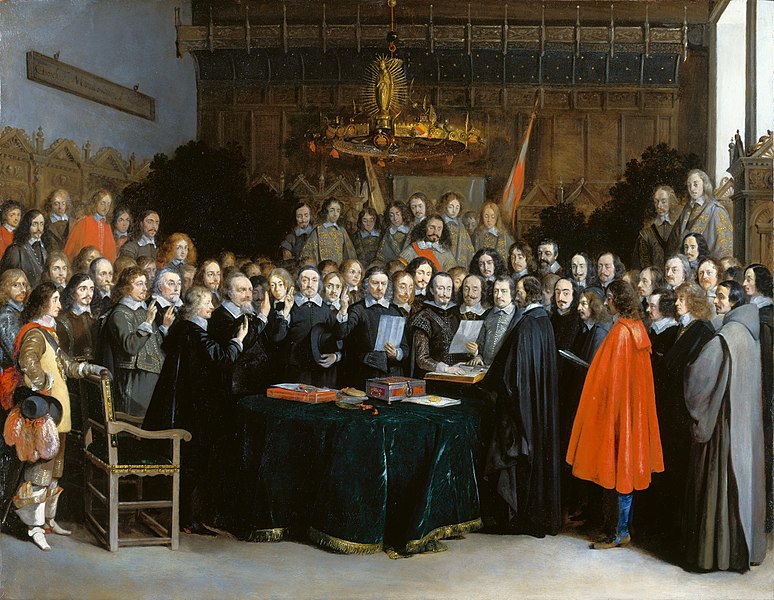
Gerard ter Borch, The Swearing of the Oath of Ratification of the Treaty of Münster, 1648, The National Gallery, London, UK.
The Dutch were very aware of the fact that they were living in special times. […] The fortunes of the Dutch Republic and especially Amsterdam ticked all the boxes of the classical myth.
M. Holtrop, Aurea Aetas or Golden Age: Changing Notions of the Dutch Seventeenth Century in Different Periods, p. 198.
During this period, the Dutch enjoyed an economic and cultural boom, caused chiefly by a massive influx of refugees fleeing from Catholic rule of the Habsburg-controlled territories. Among them were many merchants, scholars, and artists of Jewish and Protestant faith, coming from the Southern Netherlands and the Iberian Peninsula. Also, many prominent thinkers of the early Enlightenment found refuge in the liberal Dutch Republic, among them Rene Descartes and John Locke.

Frans Hals, Portrait of Rene Descartes, ca. 1649, Louvre, Paris, France.
The term Dutch Golden Age in our contemporary understanding was invented in the 19th century. For Europeans, this was the time of growing interest in the history of their ancestors and the myth of the Golden Age was an important element of that nationalistic narrative. This century saw the birth of a nation and in order to bring people together, a collective national identity was necessary. The concept of the Golden Age fitted that purpose by giving the Dutch people a sense of pride in their shared legacy.
Onze Gouden Eeuw, that is Our Golden Age (1897) was a seminal work on the history of the 17th century Netherlands by Pieter Lodewijk Muller, who in the preface of his work wrote:
Need I tell anyone what I mean by this? Is there a single cultivated Dutchman who does not know that those words can only apply to the period of our history that lies between the departure of Leicester in 1587 and the Peace of Utrecht in 1713?
The Golden Age came to be an established historical term among scholars of the 19th and early 20th centuries, but it was not yet established in the common language of the people and the press. According to curator Tom van der Molen, the term Golden Age was rarely used in Dutch newspapers throughout most of the 20th century but enjoyed a significant peak in the 1990s.4 This surprising finding suggests that this trend could have been connected to the rise of populism and nationalism in the Netherlands observed in the early 2000s. Furthermore, the term was used more often in the past century in non-Dutch publications. Thus in recent decades, the Golden Age came to be not only an important political tool, but also a marketing one in international publications.
It should come as no surprise to learn that still lifes, in Dutch stilleven, became a fully independent genre in the 17th century Netherlands. This was a time of exponential economic growth for the young Republic, which thrived first and foremost as an international trading power, housing one of Europe’s biggest port cities – Amsterdam. The strong shipping business along with global trading routes, enabled the Dutch to control the circulation of luxury goods, such as spices, porcelain, tea, silk, tobacco, and sugar. The Dutch also produced their own domestic goods that were in demand internationally. Both domestic and “exotic” produce played extraordinary roles in the prosperity of the Dutch Golden Age.
Still lifes from the early decades of the 17th century were more likely to depict domestic commodities which corresponded with an overall balance of Dutch trade at that point.5 Cheese and butter were chief dairy products depicted with pride in domestic still lifes, such as the one below by Clara Peeters.
What do we see? A stack of beautiful cheeses topped with a plate of butter pats, some pretzels, almonds, and figs on a porcelain plate, a silver knife with Peeters’ signature, a stoneware pitcher, a shiny glass, contrasting with the dark background, and a fresh looking bread roll.
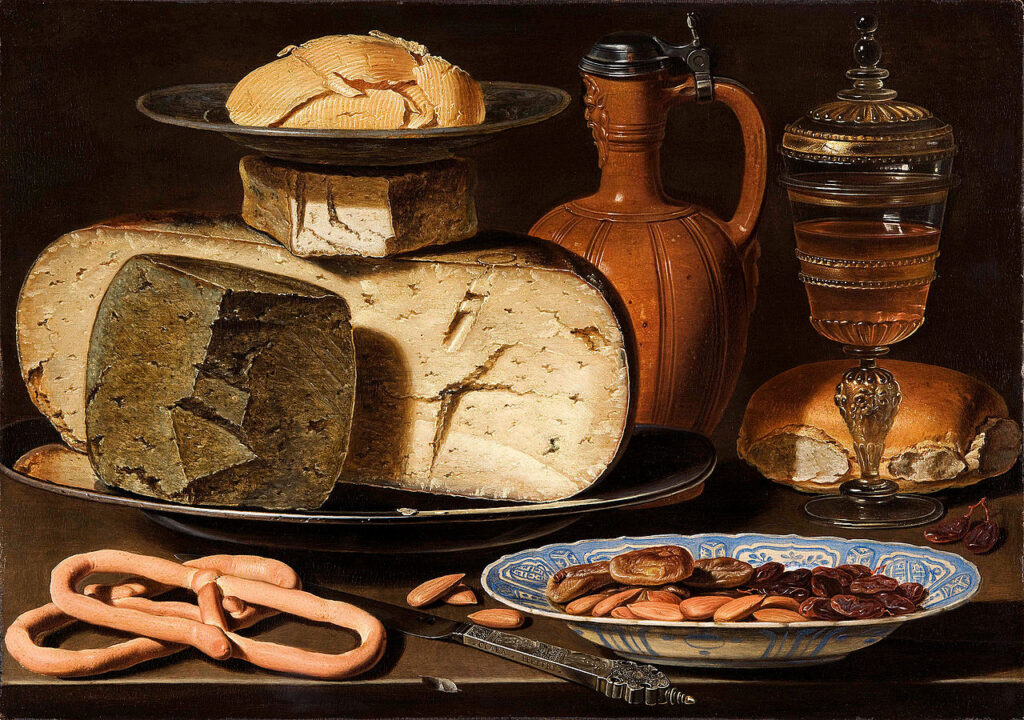
Clara Peeters, Still Life with Cheeses, Almonds and Pretzels, 1615, Mauritshuis, The Hague, Netherlands.
[…] for 17th-century Holland, cheese and butter were of great economic importance. Holland was the land of dairy products par excellence, and both of these foodstuffs belonged to the most important articles of export. Leiden butter and Tessel, Edam and Gouda cheese were internationally popular.
E. de Jongh. Still-life in the Age of Rembrandt. Auckland, 1982, p. 67.
According to Dutch art historian Eddy de Jongh, the dark green cheese seems to be a mature Edam, the massive half-wheel behind the Edam could be a Gouda, and the last, smallest piece on which a plate of butter is placed, appears to be an ewe-cheese (made of sheep milk). Although, we might think that the painting presents a rather modest meal to our modern standards, this was in fact a luxury assemblage reserved only for the privileged of society.
Clara Peeters was one of the very Flemish artists who fled from the Southern Provinces and made it to the Dutch Republic. Just like many other artists, she brought along her talent and capital to the Northern Netherlands. Recently Peeters gained significant recognition in art history, as she was one of the few female painters of the Dutch Golden Age privileged enough to pursue a career in arts.
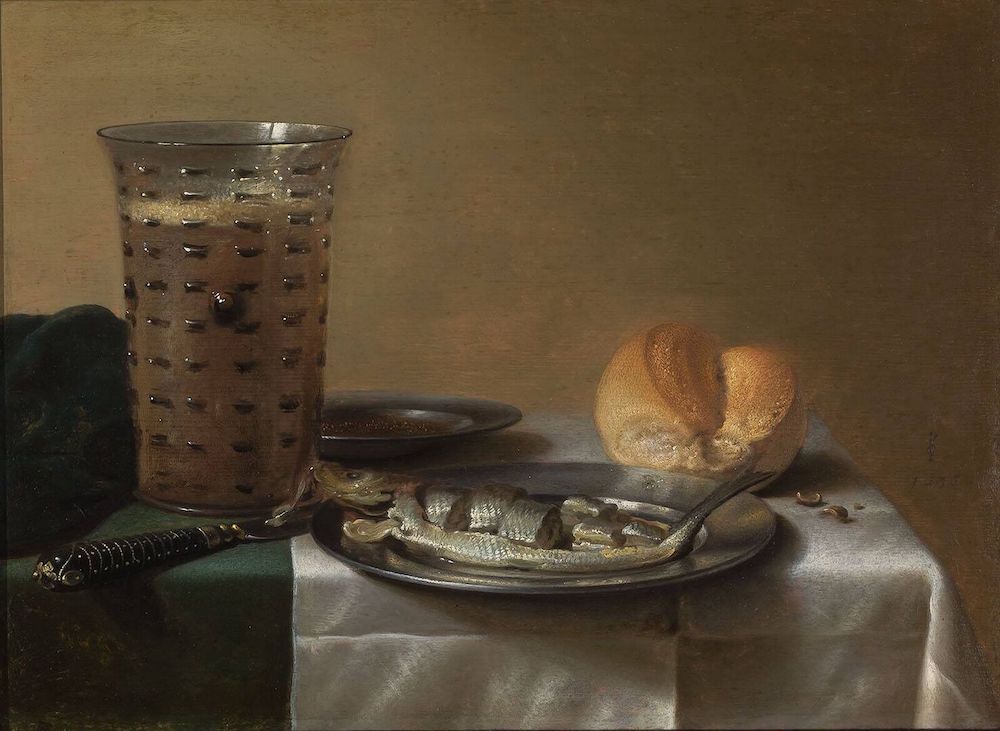
Pieter Claesz, Still life with a glass of beer and smoked herring on a plate, 1636, Museum Boijmans Van Beuningen, Rotterdam, Netherlands.
This still life by Pieter Claesz, a prolific Haarlem painter, represents the sub-genre in still life painting called monochrome banquets (het monochrome banketje). They gained particular popularity in the early decades of the 17th century. As we see, this composition is rather empty compared to that of Peeters and painted with almost tangible quality despite the limited color palette. In this case, a herring and beer are the primary subjects, as they are two local products of significant importance to the Dutch economy, placed beside a prominent bread roll (symbolizing the significance of the Baltic grain trade that was dominated by the Dutch fleets). Herring was in fact a more prominent product than cheese. It was widely eaten not only among wealthy burghers in cities but by entire fleets reaching far lands depended on barreled fish that could stay fresh for months. The Dutch were well aware that the herring industry was a goldmine that facilitated far-reaching expeditions.
Below you can see still lifes called pronkstilleven, meaning ornate still lifes, that developed in the later years of the 17th century. This was the time when the Dutch Republic gained international primacy over world trade, with luxurious goods imported from East and Southeast Asia, the Middle East, Africa, and South America. Still lifes such as those by Willem Kalf and Juriaen van Streeck were ostentatious presentations of power, reminding their owners of Dutch worldwide dominions.
Click on the gallery to read about the origins of products portrayed in pronkstilleven.
Dutch landscape belongs to the trademarks of Dutch Golden Age painting. When asked, one will most likely think of vast flatlands, very low horizons, and a powerful stretch of sky with massive clouds moving fast above the Dutch land. These landscapes indeed portray the true topography of Holland. Just like still lifes, landscape painting evolved as a genre in its own right in the 17th-century Netherlands. Of course, landscapes do make regular appearances in Renaissance painting but mostly as fantasy landscapes or ideal landscapes that have a particular symbolic or allegorical meaning referring to the mythical Arcadia. This changed in the 17th-century Netherlands when nature itself became the sole theme of an artwork.
The Haarlem School was particularly known for educating generations of excellent landscape painters, such as Cornelis van Wieringen, Esaisas van de Velde, Jan van de Velde, Pieter Molijn, Cornelis Vroom, Salomon van Ruysdael, and in its peak – Jacob van Ruisdael. Some art historians point out that the development of topographic landscape painting in the Netherlands was linked to the need for self-determination and the search for a national identity that could unify the Dutch people after the wars with the Spaniards, followed by the creation of a decentralized state.6 Three chief domains of Dutch “topographic portrait” were that of: sea, city, and het land (rural areas) that played a role in shaping the notion of “Dutchness.”7
Dutch landscapes not only proved to be of topographic value but they also carried certain symbolic meanings, telling a strong didactic and moralistic narrative.
Click on the gallery to explore the following works in greater detail!
When discussing Dutch Golden Age landscape painting, it is important to mention a unique genre of colonial landscapes created by another Haarlem painter Frans Post during his stay in Brazil (1637-1644). The Dutch West India Company seized the Portuguese and Spanish colonies in the 1630s along with extremely precious sugar cane plantations that provided sugar, a commodity bringing enormous revenue with its skyrocketing prices on the European market.
Frans Post was for a long time an obscure painter with a remarkable career. At the age of 24 he set off to Dutch Brazil with a retinue of scientists and artists curated by Johan Maurits van Nassau-Siegen, the governor general of the colonies who was also an art patron and natural science enthusiast.
During his sojourn in the northeastern coast of Brazil, Post created a series of 18 paintings depicting strategic locations for his patron. Today, only seven of them are extant. Back in Haarlem, Post created an astonishing number of different variations of Brazilian landscapes copied from his countless sketches.
We now know that Nassau-Siegen used Post’s works in his political games, either proudly exhibiting them in his private palace, Mauritshuis in The Hague, or giving them away to European rulers (for instance Louis XIV) in exchange for political favors. Such landscapes executed in a purely Dutch manner and depicting Dutch colonies overseas had a strong propagandist meaning, emphasizing Dutch domains in the Western Hemisphere.
Click on the gallery to read what lies behind Post’s tropical landscapes.
Georg Wilhelm Friedrich Hegel wrote in Lectures on Aesthetics that Dutch genre painting depicts the “Sunday of life” and this conviction persists to this day. What is Dutch genre painting? It generally depicts an interior scene, most often featuring women in the realm of a Dutch household. The most famous names associated with this genre are Johannes Vermeer, Pieter de Hooch, Gabriel Metsu, and Gerard Ter Borch.
The Dutch interiors as seen by genre painters are always neat (almost shiny), quite spacious, and richly decorated. Many 19th-century thinkers and historians claimed that these paintings were true portraits of people in the Dutch Golden Age and their everyday life, characterized by their chaste nature and Calvinist morals, expressed through the love for cleanliness. Indeed, the Dutch were already known in the 17th century among Europeans for their remarkable cleanliness.9
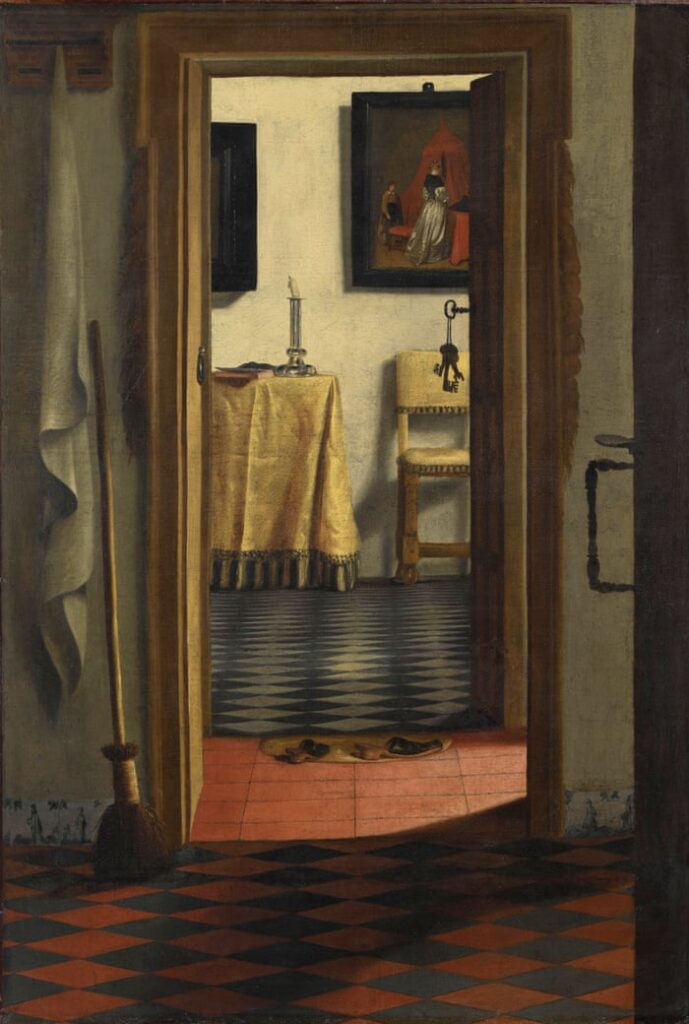
Samuel van Hoogstraten, View of an Interior/The Slippers, 1655-1662, Louvre, Paris, France.
Samuel van Hoogstraten was Rembrandt’s pupil who specialized in trompe l’oeil, which is an illusionistic trick meant to deceive the eye. His interior can be classified as a genre painting despite the lack of physical human presence since this very presence is palpable through clues left by Hoogstraten – that is the keys left in the door as if someone has just opened it, discarded slippers at the door frame, and a burning candle. Don’t you have an eerie feeling of intruding into someone’s intimate sphere? That you are being observed? This painting, similarly to many other genre scenes, was a highly sophisticated allegorical painting meant for refined art collectors.
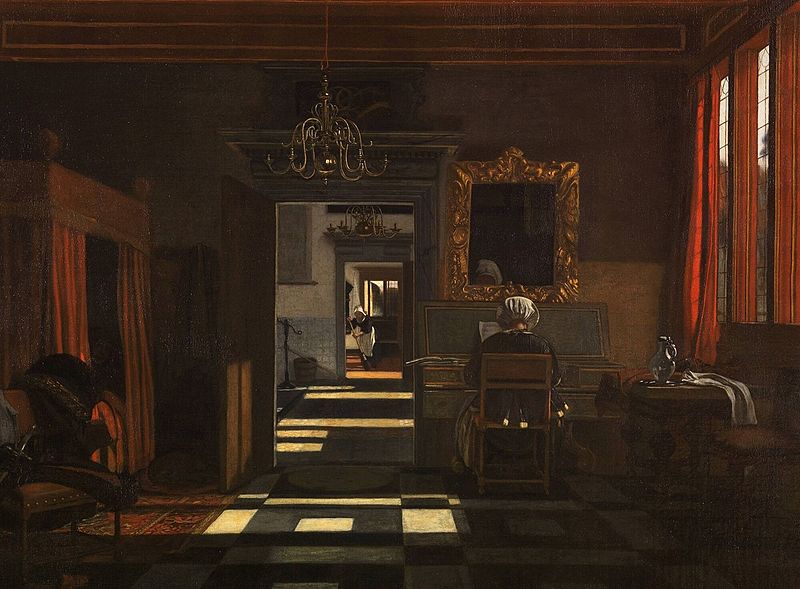
Emanuel de Witte, Interior with a Woman, ca. 1665-1670, Museum Boijmans Van Beuningen, Rotterdam, Netherlands.
In the Interior with a Woman by Emanuel de Witte, we can see a long enfilade of rooms that did not reflect the reality of 17th-century Dutch houses, for they were quite narrow and not spacious at all. Also, according to historians, such marble floors as depicted above were quite a rarity in Dutch households. They were usually laid in simpler patterns in the smaller front rooms. The interiors of Dutch households were therefore idealized types, topoi, and fictional constructs that served a more allegorical and symbolic purpose than a documental one.
It is also important to note that most average Dutch people could not afford to live in canal mansions that we see in Amsterdam or in genre scenes. Many of them lived in extreme poverty, entire families squeezed in souterrains with little sunlight and even less space.
Dutch women were known in Europe for their unprecedented freedom in managing businesses – and this was true to some extent, but as optimistic as it sounds this important role was limited only to the realm of a household and family business. This is why genre painters were so focused on women’s roles in their idealized paintings – women were an embodiment of a house and its synonym.
Click on the gallery to read about the symbolism behind the following paintings.
Genre scenes thus were not at all depictions of reality, but a refined game with an astute viewer. This could be an allegory, a set of symbols, but also a chance to lecture, surprise, or simply enjoy a collector’s eye.
In the Dutch Golden Age portraiture was extremely popular not only among aristocratic circles but also among well-to-do burghers who made their fortunes in private business. Commissioning a portrait was quite expensive and only the privileged could afford to have themselves portrayed by popular artists. The functions of portraits were not merely to remain remembered for centuries but also to carry an important, often powerful, message along with their likeness. It often indicated the sitter’s profession, status, and role in society.
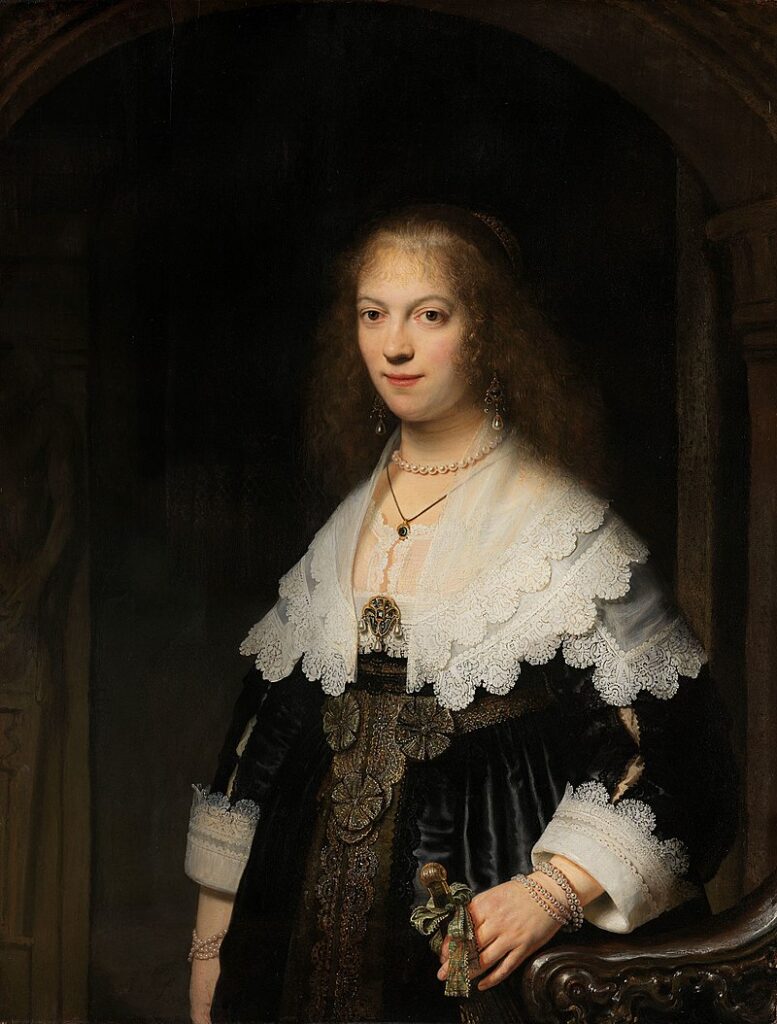
Rembrandt van Rijn, Portrait of a Woman, Possibly Maria Trip, 1639, Rijksmuseum, Amsterdam, Netherlands.
In this elegant portrait, we see Maria Trip, a young woman born into a wealthy family that traded in weapons. The Trip family belonged to the highest elite in Amsterdam and their canal mansion Trippenhuis still exists on Kloveniersburgwal in Amsterdam. In 1639, Rembrandt painted a portrait of (most likely) Maria Trip who was 20 at that time and still unmarried, therefore in this portrait, she is depicted as a woman who “has money to spend.”10 Her wealth is emphasized by the finest lace she is dressed in, as well as by the fortune of pearls she is wearing on her head, neck, and wrists.
Rembrandt van Rijn was a young man when he first arrived in Amsterdam from Leiden and commenced a star-like career. He became most popular due to his original interpretations and rendering of group portraits, a sub-genre in Dutch portraiture that depicted regents of charitable institutions, guilds, and militia (schutterij). Next to him, Frans Hals also made a great career as a portrait painter in Haarlem.
Two most famous group portraits were already mentioned at the beginning of this article, namely The Night Watch and The Anatomy Lesson of Dr. Tulp, but let’s take a look at other famous group portraits. To read their stories click on the gallery!
Tronie, meaning face or facial expression, developed exclusively in Dutch and Flemish art of the 16th and 17th centuries, serving as a bust-length physiognomic study of a “typical” human character not meant as an individual portrait. The strong individuality of a tronie and faithful observation of the expression indicates that these were painted either from life (naer het leven), or based on sketches.
Tronies had multiple purposes: they were meant as character studies for later use in history paintings, and they also served as an important part of an artist’s training. They were particularly popular among painters who ran large workshops, such as Peter Paul Rubens or Rembrandt.
In 2019 Amsterdam Museum decided to stop using the term “Dutch Golden Age” and replaced it simply with its synonym, that is “the 17th century.” The reasoning behind this decision was that the term is not representative of that century and “creates a barrier impeding efforts to tell the history of that era in ways that are relevant to the entire breadth of the population of Amsterdam and the Netherlands at large.”11 The decision was met with both extremely enthusiastic and negative reactions, among them that of the Dutch Prime Minister, Mark Rutte calling the decision nonsense.12
The criticism of the term is not new, as Johan Huizinga an important Dutch historian was never keen on this name. In 1941 he wrote:
It is the name Golden Age itself, that is wrong. It savours the aurea aetas, that mythological paradise that we already found in little tedious as schoolboys reading Ovid. If our Glorious century must have a name, let it refer to wood and steel, pitch and tar, paint and ink, audacity and piety, spirit and imagination. Golden Age would suit the 18th century better, when the gold was lying in the money boxes.
J. Huizinga, Nederland’s beschaving in de zeventiende eeuw. Haarlem 1941, pp. 174-175.
According to Huizinga the term “Golden Age” misrepresents the century because his views of the 17th century were far removed from the idea of aurea aetas. In fact, in the Dutch Republic “criminal offences met with harsh sanctions, the country was more often than not at war, ships sailed to all corners of the earth to conquer territory and build plantations: in short, this was certainly no glittering, golden Arcadia. The term is not fit for purpose because it does not describe the historical reality.”13
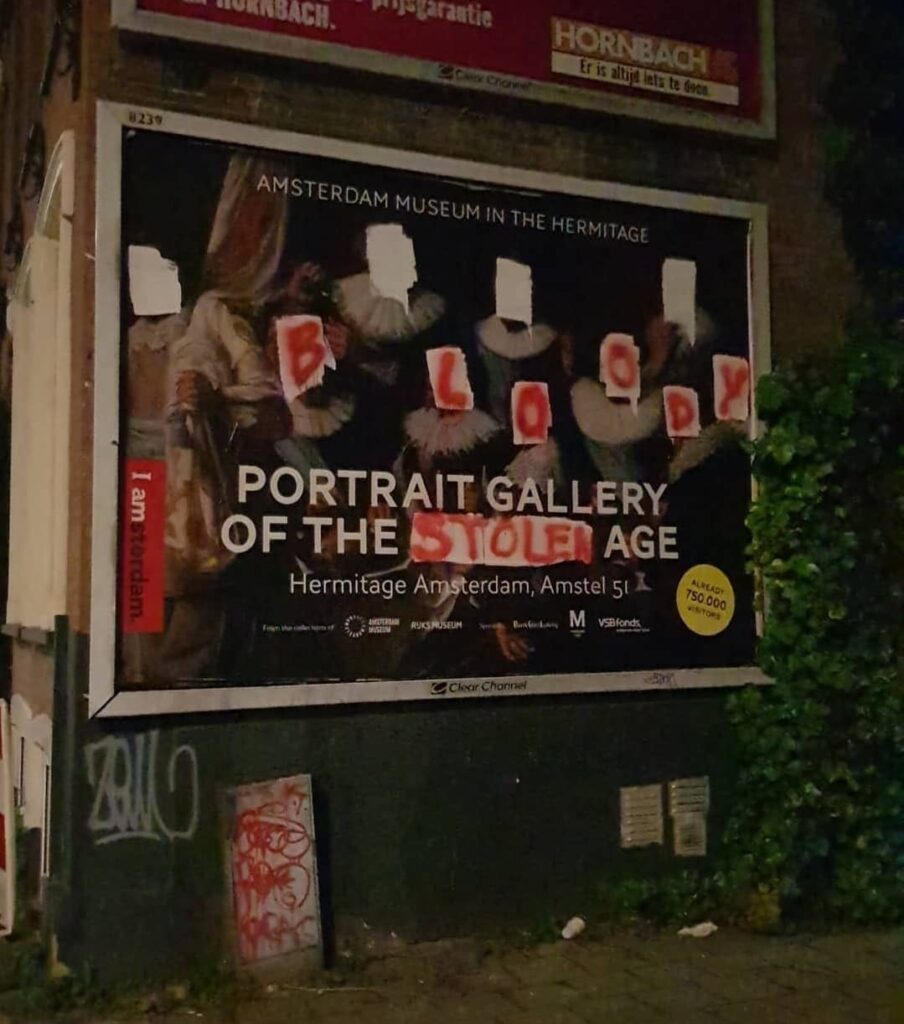
Vandalized exhibition’s poster Portrait Gallery of the Golden Age on Zeeburgerdijk, Amsterdam, Netherlands. Photo posted by Mitchell Esajas on 7 May 2019 on Instagram. CODART.
A total number of over 12.5 million people were taken into slavery by European traders.14 A great deal of prominent Dutch Golden Age paintings hanging on museum walls, such as the Brazilian landscapes by Frans Post either featured implicit colonial propaganda, or indirectly profited from slavery, such as the portraits of Oopjen Coppit and Marten Soolmans.
Oopjen Coppit was only 22 years old when portrayed in 1634 by Rembrandt. She belonged to a wealthy elite family from Amsterdam who made their fortune through trade in grain and gunpowder. She was married to Marten Soolmans, a son of Jan Soolmans, an owner of t’Vagevuur (The Fires of Purgatory), the biggest sugar refinery in the 17th-century Amsterdam.
The total shared capital of the young couple was an equivalent of 600,000 euros coming from sugar plantations in Brazil.15 In 1641 Soolmans died unexpectedly at the age of 28 and widowed Coppit.
She remarried in 1647 to her second husband, Maerten Daey, a soldier who had served in Dutch Brazil under the governorship of Johan Maurits van Nassau-Siegen. Coppit most likely did not know that Daey had an illegitimate daughter by an African woman named Francisca, whom he brutally raped during his service in Brazil.16 Francisca shared her gruesome story of rape with Paraíba pastor and a mayor of the city. Despite the complaint, Daey did not suffer from any repercussions for his rape of Francisca and returned to the Netherlands. This story is one of the many, hidden behind much venerated masterpieces of the Dutch Golden Age.
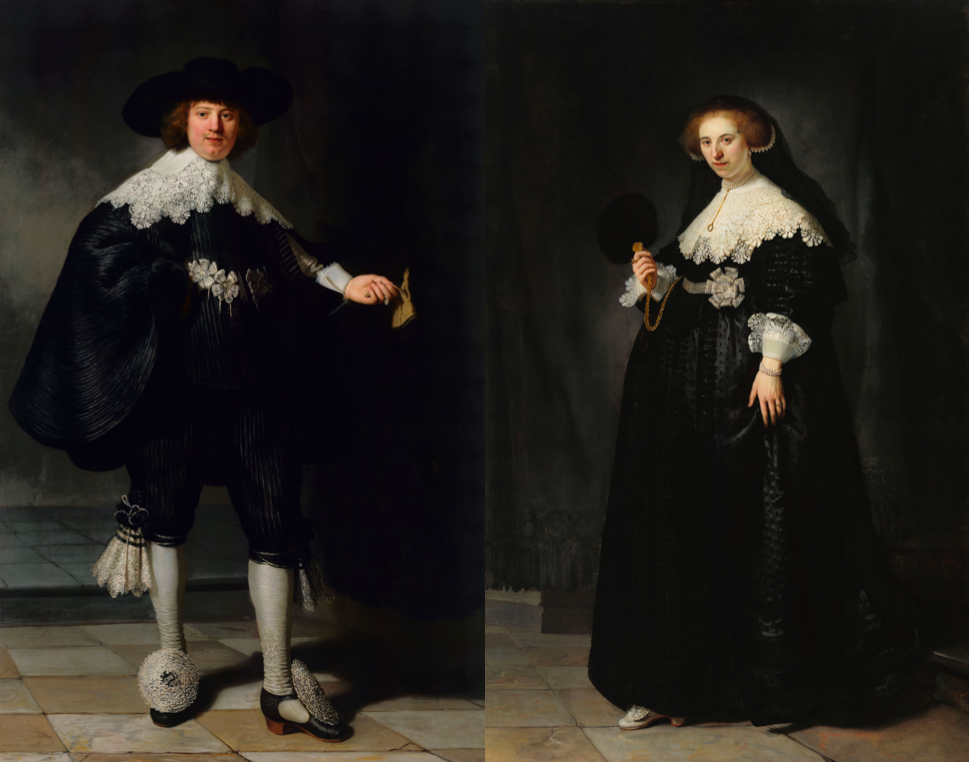
Left: Rembrandt van Rijn, Portrait of Marten Soolmans, 1634; Right: Rembrandt van Rijn, Portrait of Oopjen Coppit, 1634, Rijksmuseum, Amsterdam, Netherlands.
By no means is this article meant to downplay the excellence of artistic production of the Dutch Golden Age which is indeed striking and masterful. It is rather important to point out that the Dutch Golden Age, just like the entire historiography, tells only the story of the winners. Only a small and privileged group can remotely identify with the imagery of the Dutch Golden Age. We will definitely not learn about the realities of colonial abuse and poverty in Dutch cities from these paintings. As the director of Amsterdam Museum, Margriet Schavemaker explained:
Not everyone participated in the Golden Age, not at all.
M. Holtrop, Aurea Aetas or Golden Age: Changing Notions of the Dutch Seventeenth Century in Different Periods. In: Ed. J. Blanc, Dutch Golden Age(s). The Shaping of a Cultural Community, Turnhout 2020, p. 196.
M. Holtrop, op. cit.
M. Holtrop, op. cit., 197.
T. van der Molen: Curator’s Project: The Problem of ‘the Golden Age.’ CODART, Nov 2019 [Accessed 27 Oct 2021].
J. B. Hochstrasser. Still Life and Trade in the Dutch Golden Age. New Haven, 2007, p. 22.
By no means do I mean the term „national identity” in our contemporary understanding of a nation deriving from the 19th-century notions of a nation and national identity.
A. Ziemba. Iluzja a Realizm. Gra z widzem w sztuce holenderskiej 1580-1660 (Illusion and Realism – The Game with the Spectator in Dutch Art 1580–1660). Warsaw 2015, p. 239.
See: B. & P. Corrêa do Lago. Frans Post (1612-1680): Catalogue Raisonné. Milan 2007.
See: P. Oczko. Bezem en kruis: de Hollandse schoonmaakcultuur of de geschiedenis van een obsessie (Broom and cross : the culture of cleanliness in Holland, or the history of an obsession). Leiden 2020.
Portrait of a Woman, Possibly Maria Trip. Rijksmuseum Database [Accessed 01.11.2021].
T. van der Molen, op. cit.
H. Keultjes. Rutte: ‘Gouden Eeuw juist prachtige term, wat een onzin, pff.’ Algemeen Dagblad, 13 Sep 2019.
T. van der Molen, op. cit.
E. Sint Nicolaas & V. Smeulders. Slavery: the Story of João, Wally, Oopjen, Paulus, van Bengalen, Surapati, Sapali, Tula, Dirk, Lohkay. Amsterdam, 2021, p. 17.
E. Sint Nicolaas & V. Smeulders, op. cit., p. 110-119.
E. Sint Nicolaas & V. Smeulders, op. cit., p. 119-121.
DailyArt Magazine needs your support. Every contribution, however big or small, is very valuable for our future. Thanks to it, we will be able to sustain and grow the Magazine. Thank you for your help!